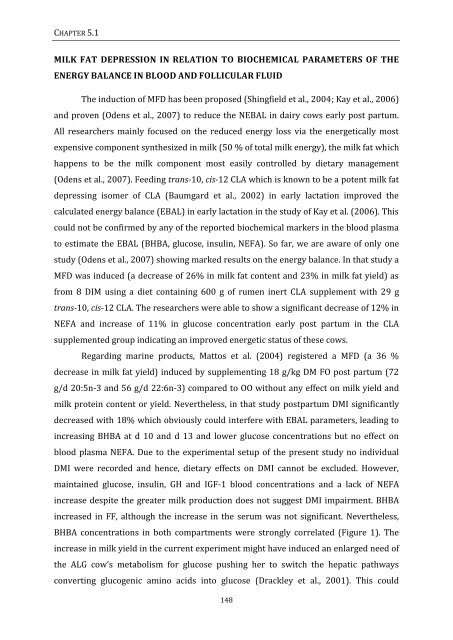view - Department of Reproduction, Obstetrics and Herd Health
view - Department of Reproduction, Obstetrics and Herd Health
view - Department of Reproduction, Obstetrics and Herd Health
You also want an ePaper? Increase the reach of your titles
YUMPU automatically turns print PDFs into web optimized ePapers that Google loves.
CHAPTER 5.1<br />
MILK FAT DEPRESSION IN RELATION TO BIOCHEMICAL PARAMETERS OF THE<br />
ENERGY BALANCE IN BLOOD AND FOLLICULAR FLUID<br />
The induction <strong>of</strong> MFD has been proposed (Shingfield et al., 2004; Kay et al., 2006)<br />
<strong>and</strong> proven (Odens et al., 2007) to reduce the NEBAL in dairy cows early post partum.<br />
All researchers mainly focused on the reduced energy loss via the energetically most<br />
expensive component synthesized in milk (50 % <strong>of</strong> total milk energy), the milk fat which<br />
happens to be the milk component most easily controlled by dietary management<br />
(Odens et al., 2007). Feeding trans-10, cis-12 CLA which is known to be a potent milk fat<br />
depressing isomer <strong>of</strong> CLA (Baumgard et al., 2002) in early lactation improved the<br />
calculated energy balance (EBAL) in early lactation in the study <strong>of</strong> Kay et al. (2006). This<br />
could not be confirmed by any <strong>of</strong> the reported biochemical markers in the blood plasma<br />
to estimate the EBAL (BHBA, glucose, insulin, NEFA). So far, we are aware <strong>of</strong> only one<br />
study (Odens et al., 2007) showing marked results on the energy balance. In that study a<br />
MFD was induced (a decrease <strong>of</strong> 26% in milk fat content <strong>and</strong> 23% in milk fat yield) as<br />
from 8 DIM using a diet containing 600 g <strong>of</strong> rumen inert CLA supplement with 29 g<br />
trans-10, cis-12 CLA. The researchers were able to show a significant decrease <strong>of</strong> 12% in<br />
NEFA <strong>and</strong> increase <strong>of</strong> 11% in glucose concentration early post partum in the CLA<br />
supplemented group indicating an improved energetic status <strong>of</strong> these cows.<br />
Regarding marine products, Mattos et al. (2004) registered a MFD (a 36 %<br />
decrease in milk fat yield) induced by supplementing 18 g/kg DM FO post partum (72<br />
g/d 20:5n-3 <strong>and</strong> 56 g/d 22:6n-3) compared to OO without any effect on milk yield <strong>and</strong><br />
milk protein content or yield. Nevertheless, in that study postpartum DMI significantly<br />
decreased with 18% which obviously could interfere with EBAL parameters, leading to<br />
increasing BHBA at d 10 <strong>and</strong> d 13 <strong>and</strong> lower glucose concentrations but no effect on<br />
blood plasma NEFA. Due to the experimental setup <strong>of</strong> the present study no individual<br />
DMI were recorded <strong>and</strong> hence, dietary effects on DMI cannot be excluded. However,<br />
maintained glucose, insulin, GH <strong>and</strong> IGF-1 blood concentrations <strong>and</strong> a lack <strong>of</strong> NEFA<br />
increase despite the greater milk production does not suggest DMI impairment. BHBA<br />
increased in FF, although the increase in the serum was not significant. Nevertheless,<br />
BHBA concentrations in both compartments were strongly correlated (Figure 1). The<br />
increase in milk yield in the current experiment might have induced an enlarged need <strong>of</strong><br />
the ALG cow’s metabolism for glucose pushing her to switch the hepatic pathways<br />
converting glucogenic amino acids into glucose (Drackley et al., 2001). This could<br />
148









